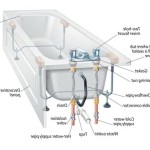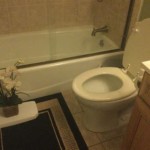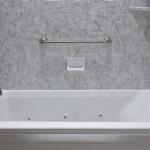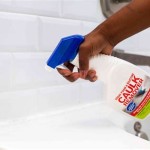Best Bathtub Shower Combos for Small Bathrooms
Maximizing space in a small bathroom often necessitates strategic design choices. A bathtub shower combo is a popular solution, offering the functionality of both a bathtub and a shower without requiring the footprint of two separate fixtures. Selecting the right bathtub shower combo for a small bathroom involves careful consideration of factors such as size, configuration, material, and features. This article will explore various aspects to consider when choosing a bathtub shower combo to optimize a small bathroom space.
Understanding Space Limitations and Configurations
The primary constraint in a small bathroom is, of course, limited space. Accurate measurements are crucial before starting the selection process. Record the length, width, and height of the available area, noting any obstructions like pipes, windows, or doors. These measurements will determine the maximum dimensions of the bathtub shower combo that can be accommodated.
Several bathtub configurations are suitable for small spaces. Alcove tubs, designed to fit snugly between three walls, are a common and efficient choice. Corner bathtubs, while sometimes larger, can effectively utilize otherwise awkward spaces. A standard alcove bathtub typically measures 60 inches in length, but shorter options, such as 54-inch models, are available for particularly compact bathrooms. Deep soaking tubs, though providing a luxurious bathing experience, may not be the best choice for small spaces due to their increased depth and potentially larger footprint.
Consider the placement of the existing plumbing. Relocating plumbing can be a significant expense, so choosing a bathtub shower combo that aligns with the current plumbing configuration is often the most practical approach. If relocation is unavoidable, factor in the cost and complexity of the plumbing work during the decision-making process.
Material Selection: Durability, Maintenance, and Aesthetics
The material of the bathtub shower combo significantly impacts its durability, maintenance requirements, and overall aesthetic appeal. Several materials are commonly used, each with its own advantages and disadvantages.
Acrylic is a popular choice due to its lightweight nature, affordability, and resistance to chipping and cracking. Acrylic bathtubs also tend to retain heat well, providing a more comfortable bathing experience. Regular cleaning with non-abrasive cleaners is generally sufficient to maintain an acrylic bathtub’s appearance. However, acrylic can be susceptible to scratching and staining if not properly cared for.
Cast iron bathtubs are known for their exceptional durability and heat retention. Enamel-coated cast iron is highly resistant to scratches and chips, making it a long-lasting option. However, cast iron bathtubs are significantly heavier than acrylic models, requiring a reinforced floor structure for support. The heavy weight also makes installation more challenging and costly. Cast iron bathtubs are typically more expensive than acrylic options.
Steel bathtubs, often porcelain-enameled, are another durable and relatively affordable choice. While not as effective at retaining heat as cast iron or acrylic, steel bathtubs are lighter than cast iron and offer good resistance to scratches and stains. However, the enamel coating can be susceptible to chipping if subjected to heavy impact.
Fiberglass is a less expensive option but tends to be less durable than acrylic, cast iron, or steel. Fiberglass bathtubs are lightweight and easy to install, but they are more prone to scratching, cracking, and staining. While more affordable upfront, the shorter lifespan of a fiberglass bathtub may result in higher replacement costs in the long run.
The shower surround material should also be considered. Options include tile, acrylic, fiberglass, and composite materials. Tile offers a wide range of design possibilities and is highly durable, but it requires regular cleaning of grout lines to prevent mold and mildew growth. Acrylic and fiberglass surrounds are easy to clean and relatively inexpensive, but they may not be as aesthetically pleasing as tile. Composite materials offer a good balance of durability, aesthetics, and ease of maintenance.
Features and Accessories: Enhancing Functionality and Comfort
Beyond the basic bathtub and shower functionality, various features and accessories can enhance the bathing experience and improve the practicality of a bathtub shower combo in a small bathroom.
Showerheads come in a variety of styles, including fixed showerheads, handheld showerheads, and rain showerheads. A handheld showerhead can be particularly useful in a small bathroom, as it allows for easy rinsing and cleaning of the shower area. Consider a showerhead with multiple spray settings to customize the bathing experience.
Shower doors or curtains are essential for preventing water from splashing out of the bathtub shower combo. Shower doors offer a more permanent and aesthetically pleasing solution, while shower curtains are more affordable and easier to install. Frameless shower doors can create a more open and spacious feel in a small bathroom. Bi-fold or sliding shower doors are good options if space is limited near the shower entrance.
Built-in shelves or niches provide convenient storage for soaps, shampoos, and other bath essentials. These storage solutions help to keep the shower area organized and clutter-free. If the bathtub shower combo does not come with built-in storage, consider adding a shower caddy or wall-mounted shelves.
Grab bars can improve safety and accessibility, particularly for individuals with mobility issues. Installing grab bars near the bathtub and shower entrance can provide added support and prevent falls. Choose grab bars that are ADA-compliant for maximum safety and accessibility.
Consider the inclusion of a faucet set with a diverter valve. This allows for easy switching between the bathtub faucet and the showerhead. Choose a faucet set that complements the overall style of the bathroom and offers reliable performance.
Lighting is another crucial aspect to consider. Adequate lighting in the shower area enhances visibility and safety. Recessed lighting, a waterproof shower light, or even LED strip lighting can be incorporated to improve the lighting in the tub and shower area.
Ventilation is critical to prevent mold and mildew growth. Ensure that the bathroom has adequate ventilation, either through a window or an exhaust fan. The exhaust fan should be properly sized for the bathroom’s square footage to effectively remove moisture from the air.
A comfortable bathtub design enhances the overall bathing experience. Consider a bathtub with an ergonomic backrest or armrests for added comfort. Deeper bathtubs allow for a more immersive soaking experience.
Finally, consider the overall aesthetic of the bathtub shower combo. Choose a style that complements the existing bathroom décor and creates a cohesive look. A well-designed bathtub shower combo can significantly enhance the appearance of a small bathroom.
In summary, selecting the best bathtub shower combo for a small bathroom involves careful consideration of space limitations, material selection, and desired features. By taking these factors into account, it is possible to create a functional and aesthetically pleasing bathing area that optimizes space and enhances the overall bathroom experience.

2024 Bathtub And Shower Combo Guide Modernize

8 Bathtub And Shower Combo Ideas The Family Handyman

Top 5 Walk In Bathtub Shower Combo Ideas And Benefits

Can A Freestanding Bathtub Have Shower Tyrrell And Laing

8 Bathtub And Shower Combo Ideas The Family Handyman

Trend Alert 8 Narrow Bathrooms That Rock Tubs In The Shower Rubenstein Supply Company

2024 Bathtub And Shower Combo Guide Modernize

New This Week 5 Beautiful Bathrooms With A Shower Tub Combo

Walk In Tub Shower Combo Kohler Bath

Top 5 Walk In Bathtub Shower Combo Ideas And Benefits








